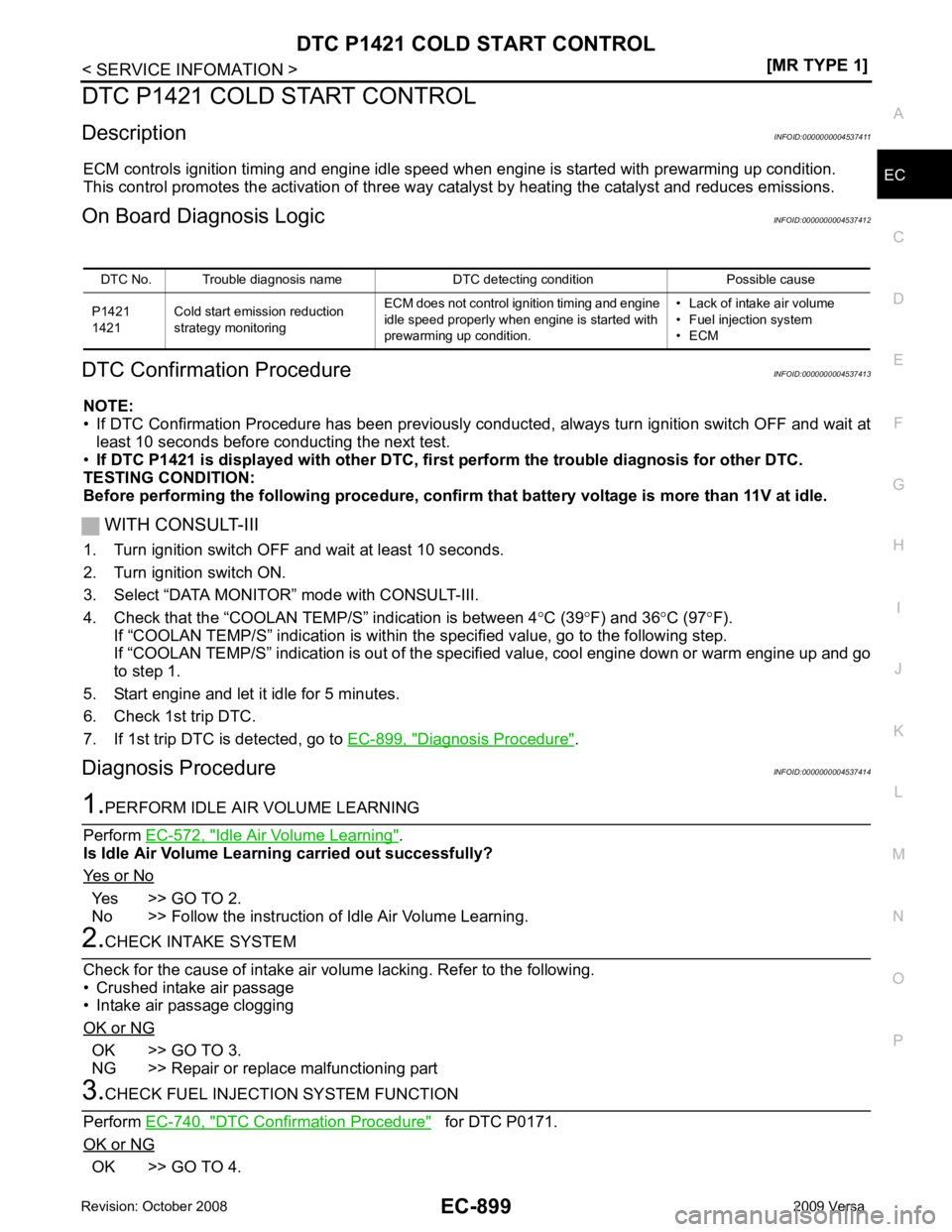2009 NISSAN TIIDA e control
[x] Cancel search: e controlPage 2250 of 4331
![NISSAN TIIDA 2009 Service Repair Manual EC-894< SERVICE INFOMATION >
[MR TYPE 1]
DTC P1217 ENGINE
OVER TEMPERATURE
*1: Turn the ignition switch ON.
*2: Engine running at 3,000 rpm for 10 minutes.
*3: Drive at 90 km/h (55 MPH) for 30 minute NISSAN TIIDA 2009 Service Repair Manual EC-894< SERVICE INFOMATION >
[MR TYPE 1]
DTC P1217 ENGINE
OVER TEMPERATURE
*1: Turn the ignition switch ON.
*2: Engine running at 3,000 rpm for 10 minutes.
*3: Drive at 90 km/h (55 MPH) for 30 minute](/manual-img/5/57398/w960_57398-2249.png)
EC-894< SERVICE INFOMATION >
[MR TYPE 1]
DTC P1217 ENGINE
OVER TEMPERATURE
*1: Turn the ignition switch ON.
*2: Engine running at 3,000 rpm for 10 minutes.
*3: Drive at 90 km/h (55 MPH) for 30 minutes and then let idle for 10 minutes.
*4: After 60 minutes of cool down time.
For more informat ion, refer to CO-32 .
Component Inspection INFOID:0000000004537400
COOLING FAN MOTOR
Model with A/C
1. Disconnect cooling fan motor harness connectors.
2. Supply cooling fan motor terminals with battery voltage and check operation.
Cooling fan motor should operate.
If NG, replace cooling fan motor.
Models without A/C
1. Disconnect cooling fan motor harness connectors.
2. Supply cooling fan motor terminals with battery voltage and check operation.
Cooling fan motor should operate.
If NG, replace cooling fan motor. OFF*
4
10 • Coolant return from res-
ervoir tank to radiator • Visual Should be initial level in
reservoir tank See
CO-35, " Inspection " .
OFF 11 • Water control valve • Remove and inspect
the valve Within the specified value See
CO-47, " Removal
and Installation "
OFF 12 • Cylinder head • Straight gauge feeler
gauge0.1 mm (0.004 in) Maxi-
mum distortion (warping) See
EM-185 .
13 • Cylinder block and pis- tons • Visual No scuffing on cylinder
walls or piston See
EM-199 .
Engine Step Inspection item Equipment Standard Reference page Terminals
(+) (-)
Cooling fan motor 1 2 SEF888V
Speed
terminals
(+) ( −)
Cooling fan motor Low 1 4
2 3
High 1 and 2 3 and 4 SEF734W
Page 2251 of 4331
![NISSAN TIIDA 2009 Service Repair Manual DTC P1225 TP SENSOR
EC-895
< SERVICE INFOMATION >
[MR TYPE 1] C
D E
F
G H
I
J
K L
M A EC
NP
O
DTC P1225 TP SENSOR
Component Description INFOID:0000000004537401
Electric throttle control actuator NISSAN TIIDA 2009 Service Repair Manual DTC P1225 TP SENSOR
EC-895
< SERVICE INFOMATION >
[MR TYPE 1] C
D E
F
G H
I
J
K L
M A EC
NP
O
DTC P1225 TP SENSOR
Component Description INFOID:0000000004537401
Electric throttle control actuator](/manual-img/5/57398/w960_57398-2250.png)
DTC P1225 TP SENSOR
EC-895
< SERVICE INFOMATION >
[MR TYPE 1] C
D E
F
G H
I
J
K L
M A EC
NP
O
DTC P1225 TP SENSOR
Component Description INFOID:0000000004537401
Electric throttle control actuator consists of throttle control motor,
throttle position sensor, etc. The throttle position sensor responds to
the throttle valve movement.
The throttle position sensor has two sensors. These sensors are a
kind of potentiometers which transform the throttle valve position into
output voltage, and emit the voltage signal to the ECM. In addition,
these sensors detect the opening and closing speed of the throttle
valve and feed the voltage signals to the ECM. The ECM judges the
current opening angle of the throttle valve from these signals and the
ECM controls the throttle control motor to make the throttle valve
opening angle properly in response to driving condition.
On Board Diagnosis Logic INFOID:0000000004537402
The MIL will not light up for this diagnosis.
DTC Confirmation Procedure INFOID:0000000004537403
NOTE:
If DTC Confirmation Procedure has been previously conduc ted, always turn ignition switch OFF and wait at
least 10 seconds before conducting the next test.
TESTING CONDITION:
Before performing the following procedure, confirm that battery voltage is more than 10V at idle.
1. Turn ignition switch ON.
2. Turn ignition switch OFF and wait at least 10 seconds.
3. Turn ignition switch ON.
4. Check 1st trip DTC.
5. If 1st trip DTC is detected, go to EC-895, " Diagnosis Procedure " .
Diagnosis Procedure INFOID:00000000045374041.
CHECK ELECTRIC THROTTLE CONTROL ACTUATOR VISUALLY
1. Turn ignition switch OFF.
2. Remove the intake air duct.
3. Check if foreign matter is c aught between the throttle valve (1)
and the housing.
- : Vehicle front
OK or NG OK >> GO TO 2.
NG >> Remove the foreign matter and clean the electric throttle
control actuator inside. 2.
REPLACE ELECTRIC THROTTLE CONTROL ACTUATOR
1. Replace the electric throttle control actuator.
2. Perform EC-572, " Throttle Valve Closed Position Learning " .
3. Perform EC-572, " Idle Air Volume Learning " . PBIB0145E
DTC No. Trouble diagnosis name DTC detecting condition Possible cause
P1225
1225 Closed throttle position
learning performance Closed throttle position learning value is exces-
sively low. • Electric throttle control actuator
(TP sensor 1 and 2) BBIA0711E
Page 2253 of 4331
![NISSAN TIIDA 2009 Service Repair Manual DTC P1226 TP SENSOR
EC-897
< SERVICE INFOMATION >
[MR TYPE 1] C
D E
F
G H
I
J
K L
M A EC
NP
O
DTC P1226 TP SENSOR
Component Description INFOID:0000000004537406
Electric throttle control actuator NISSAN TIIDA 2009 Service Repair Manual DTC P1226 TP SENSOR
EC-897
< SERVICE INFOMATION >
[MR TYPE 1] C
D E
F
G H
I
J
K L
M A EC
NP
O
DTC P1226 TP SENSOR
Component Description INFOID:0000000004537406
Electric throttle control actuator](/manual-img/5/57398/w960_57398-2252.png)
DTC P1226 TP SENSOR
EC-897
< SERVICE INFOMATION >
[MR TYPE 1] C
D E
F
G H
I
J
K L
M A EC
NP
O
DTC P1226 TP SENSOR
Component Description INFOID:0000000004537406
Electric throttle control actuator consists of throttle control motor,
throttle position sensor, etc. The throttle position sensor responds to
the throttle valve movement.
The throttle position sensor has two sensors. These sensors are a
kind of potentiometers which transform the throttle valve position into
output voltage, and emit the voltage signal to the ECM. In addition,
these sensors detect the opening and closing speed of the throttle
valve and feed the voltage signals to the ECM. The ECM judges the
current opening angle of the throttle valve from these signals and the
ECM controls the throttle control motor to make the throttle valve
opening angle properly in response to driving condition.
On Board Diagnosis Logic INFOID:0000000004537407
The MIL will not light up for this diagnosis.
DTC Confirmation Procedure INFOID:0000000004537408
NOTE:
If DTC Confirmation Procedure has been previously conduc ted, always turn ignition switch OFF and wait at
least 10 seconds before conducting the next test.
TESTING CONDITION:
Before performing the following procedure, confirm that battery voltage is more than 10V at idle.
1. Turn ignition switch ON.
2. Turn ignition switch OFF and wait at least 10 seconds.
3. Turn ignition switch ON.
4. Repeat steps 3 and 4 for 32 times.
5. Check 1st trip DTC.
6. If 1st trip DTC is detected, go to EC-897, " Diagnosis Procedure " .
Diagnosis Procedure INFOID:00000000045374091.
CHECK ELECTRIC THROTTLE CONTROL ACTUATOR VISUALLY
1. Turn ignition switch OFF.
2. Remove the intake air duct.
3. Check if foreign matter is c aught between the throttle valve (1)
and the housing.
- : Vehicle front
OK or NG OK >> GO TO 2.
NG >> Remove the foreign matter and clean the electric throttle control actuator inside. 2.
REPLACE ELECTRIC THROTTLE CONTROL ACTUATOR
1. Replace the electric throttle control actuator.
2. Perform EC-572, " Throttle Valve Closed Position Learning " . PBIB0145E
DTC No. Trouble diagnosis name DTC detecting condition Possible cause
P1226
1226 Closed throttle position
learning performance Closed throttle position learning is not per-
formed successfully, repeatedly. • Electric throttle control actuator
(TP sensor 1 and 2) BBIA0711E
Page 2254 of 4331

Idle Air Volume Learning " .
>> INSPECTION END
Removal and Installation INFOID:0000000004537410
ELECTRIC THROTTLE CONTROL ACTUATOR
Refer to EM-141 .
Page 2255 of 4331

EC
NP
O
DTC P1421 COLD START CONTROL
Description INFOID:0000000004537411
ECM controls ignition timing and engine idle speed when engine is started with prewarming up condition.
This control promotes the activation of three way ca talyst by heating the catalyst and reduces emissions.
On Board Diagnosis Logic INFOID:0000000004537412
DTC Confirmation Procedure INFOID:0000000004537413
NOTE:
• If DTC Confirmation Procedure has been previously conduc ted, always turn ignition switch OFF and wait at
least 10 seconds before conducting the next test.
• If DTC P1421 is displayed with other DTC, firs t perform the trouble diagnosis for other DTC.
TESTING CONDITION:
Before performing the following procedure, confirm that battery voltage is more than 11V at idle.
WITH CONSULT-III
1. Turn ignition switch OFF and wait at least 10 seconds.
2. Turn ignition switch ON.
3. Select “DATA MONITOR” mode with CONSULT-III.
4. Check that the “COOLAN TE MP/S” indication is between 4°C (39 °F) and 36 °C (97 °F).
If “COOLAN TEMP/S” indication is within the specified value, go to the following step.
If “COOLAN TEMP/S” indication is out of the s pecified value, cool engine down or warm engine up and go
to step 1.
5. Start engine and let it idle for 5 minutes.
6. Check 1st trip DTC.
7. If 1st trip DTC is detected, go to EC-899, " Diagnosis Procedure " .
Diagnosis Procedure INFOID:0000000004537414Idle Air Volume Learning " .
Is Idle Air Volume Learning carried out successfully?
Yes or No Yes >> GO TO 2.
No >> Follow the instruction of Idle Air Volume Learning. OK >> GO TO 3.
NG >> Repair or replace malfunctioning part DTC Confirmation Procedure " for DTC P0171.
OK or NG OK >> GO TO 4.DTC No. Trouble diagnosis name DTC detecting condition Possible cause
P1421
1421 Cold start emission reduction
strategy monitoring ECM does not control ignition timing and engine
idle speed properly when engine is started with
prewarming up condition. • Lack of intake air volume
• Fuel injection system
• ECM
Page 2277 of 4331

EC
NP
O
DTC P1805 BRAKE SWITCH
Description INFOID:0000000004537442
Brake switch signal is applied to the ECM through t he stop lamp switch when the brake pedal is depressed.
This signal is used mainly to decrease the engine speed when the vehicle is driving.
CONSULT-III Reference Val ue in Data Monitor Mode INFOID:0000000004537443
Specification data are reference values.
On Board Diagnosis Logic INFOID:0000000004537444
The MIL will not light up for this self-diagnosis.
FAIL-SAFE MODE When the malfunction is detected, the ECM enters in fail-safe mode.
DTC Confirmation Procedure INFOID:0000000004537445
1. Turn ignition switch ON.
2. Fully depress the brake pedal for at least 5 seconds.
3. Erase the DTC.
4. Check 1st trip DTC.
5. If 1st trip DTC is detected, go to EC-923, " Diagnosis Procedure " .
MONITOR ITEM CONDITION SPECIFICATION
BRAKE SW • Ignition switch: ON Brake pedal: Fully released OFF
Brake pedal: Slightly depressed ON DTC No. Trouble diagnosis name DTC detecting condition Possible cause
P1805
1805 Brake switch A brake switch signal is not sent to ECM for
extremely long time while the vehicle is driv-
ing. • Harness or connectors
(Stop lamp switch circuit is open or shorted.)
• Stop lamp switch Engine operation condition in fail-fail safe mode
ECM controls the electric throttle control actuator by regulating the throttle opening to a small range. Therefore, acceleration will be poor.
Vehicle condition Driving condition Engine: Idling NormalAccelerating Poor acceleration
Page 2281 of 4331

EC
NP
O
DTC P2100, P2103 THROTTLE
CONTROL MOTOR RELAY
Component Description INFOID:0000000004537449
Power supply for the throttle control motor is provided to the ECM via throttle control motor relay. The throttle
control motor relay is ON/OFF controlled by the ECM. When the ignition switch is turned ON, the ECM sends
an ON signal to throttle control motor relay and batte ry voltage is provided to the ECM. When the ignition
switch is turned OFF, the ECM sends an OFF signal to throttle control motor relay and battery voltage is not
provided to the ECM.
CONSULT-III Reference Val ue in Data Monitor Mode INFOID:0000000004537450
Specification data are reference values.
On Board Diagnosis Logic INFOID:0000000004537451
These self-diagnoses have one trip detection logic.
FAIL-SAFE MODE When the malfunction is detected, ECM ent ers fail-safe mode and the MIL lights up.
DTC Confirmation Procedure INFOID:0000000004537452
NOTE:
If DTC Confirmation Procedure has been previously conduc ted, always turn ignition switch OFF and wait at
least 10 seconds before conducting the next test.
PROCEDURE FOR DTC P2100 1. Turn ignition switch ON and wait at least 2 seconds.
2. Start engine and let it idle for 5 seconds.
3. Check 1st trip DTC.
4. If DTC is detected, go to EC-927, " Diagnosis Procedure " .
PROCEDURE FOR DTC P2103 TESTING CONDITION:
Before performing the following procedure, confirm that battery voltage is more than 10V at idle.
1. Turn ignition switch ON and wait at least 1 second.
2. Check DTC.
3. If DTC is detected, go to EC-927, " Diagnosis Procedure " .
MONITOR ITEM CONDITION SPECIFICATION
THRTL RELAY • Ignition switch: ON ON DTC No. Trouble diagnosis name DTC detecting condition Possible cause
P2100
2100 Throttle control motor
relay circuit open ECM detects a voltage of power source for
throttle control motor is excessively low. • Harness or connectors
(Throttle control motor relay circuit is
open)
• Throttle control motor relay
P2103
2103 Throttle control motor
relay circuit short ECM detects the throttle
control motor relay is
stuck ON. • Harness or connectors
(Throttle control motor relay circuit is
shorted)
• Throttle control motor relay Engine operating condition in fail-safe mode
ECM stops the electric throttle control actuator control, throttle valve is maintained at a fixed opening (approx. 5 degrees) b y the return
spring.
Page 2283 of 4331
![NISSAN TIIDA 2009 Service Repair Manual DTC P2100, P2103 THROTTLE
CONTROL MOTOR RELAY
EC-927
< SERVICE INFOMATION >
[MR TYPE 1] C
D E
F
G H
I
J
K L
M A EC
NP
O
Do not use ECM ground terminals wh
en measuring input/output voltage. Doing so NISSAN TIIDA 2009 Service Repair Manual DTC P2100, P2103 THROTTLE
CONTROL MOTOR RELAY
EC-927
< SERVICE INFOMATION >
[MR TYPE 1] C
D E
F
G H
I
J
K L
M A EC
NP
O
Do not use ECM ground terminals wh
en measuring input/output voltage. Doing so](/manual-img/5/57398/w960_57398-2282.png)
DTC P2100, P2103 THROTTLE
CONTROL MOTOR RELAY
EC-927
< SERVICE INFOMATION >
[MR TYPE 1] C
D E
F
G H
I
J
K L
M A EC
NP
O
Do not use ECM ground terminals wh
en measuring input/output voltage. Doing so may result in dam-
age to the ECM's transistor. Use a ground ot her than ECM terminals, such as the ground.
: Average voltage for pulse signal (Actual pulse signal can be confirmed by oscilloscope.)
Diagnosis Procedure INFOID:00000000045374541.
CHECK THROTTLE CONTROL MOTOR RELAY POWER SUPPLY CIRCUIT-I
1. Turn ignition switch OFF.
2. Check voltage between ECM terminal 15 and ground with CON- SULT-III or tester.
OK or NG OK >> GO TO 5.
NG >> GO TO 2. 2.
CHECK THROTTLE CONTROL MOTOR RELAY POWER SUPPLY CIRCUIT-II
1. Disconnect ECM harness connector.
2. Disconnect IPDM E/R harness connector E46.
3. Check continuity between ECM terminal 15 and IPDM E/R terminal 46. Refer to Wiring Diagram.
4. Also check harness for short to ground and short to power.
OK or NG OK >> GO TO 4.
NG >> GO TO 3. TERMI-
NAL
NO. WIRE
COLOR ITEM CONDITION DATA (DC Voltage)
1 L Throttle control motor
(Open) [Ignition switch: ON]
• Engine stopped
• Shift lever: D (A/T, CVT), 1st (M/T)
• Accelerator pedal: Fully depressed Approximately 3.2V
2 SB Throttle control motor power
supply [Ignition switch: ON] BATTERY VOLTAGE
(11 - 14V)
4 P Throttle control motor (Close) [Ignition switch: ON]
• Engine stopped
• Shift lever: D (A/T, CVT), 1st (M/T)
• Accelerator pedal: Fully released Approximately 1.8V
15 Y Throttle control motor relay [Ignition switch: OFF]
BATTERY VOLTAGE
(11 - 14V)
[Ignition switch: ON] 0 - 1.0V PBIA8150J
PBIA8149J
Voltage: Battery voltage
PBIA9569J
Continuity should exist.